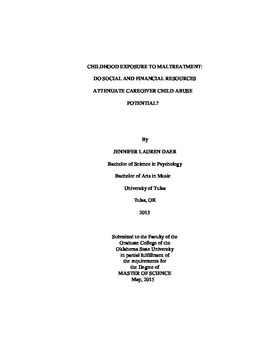| dc.contributor.advisor | Beasley, Lana O. | |
| dc.contributor.author | Daer, Jennifer | |
| dc.date.accessioned | 2016-04-15T21:49:18Z | |
| dc.date.available | 2016-04-15T21:49:18Z | |
| dc.date.issued | 2015-05-01 | |
| dc.identifier.uri | https://hdl.handle.net/11244/33407 | |
| dc.description.abstract | The present study sought to evaluate the role of protective factors such as social support and family resources on the relation between childhood abuse history and child abuse potential in a sample of caregivers and parents at significant risk for child abuse and neglect. This relation was examined using pre-service data from a randomized clinical trial (RCT) of a home-based parenting program. It was hypothesized that for caregivers or parents with significant risk factors (i.e., parental depression, substance abuse, and domestic violence), childhood history of maltreatment would be positively related to child abuse potential. Additionally, it was predicted that availability of resources would contribute to this relation such that higher levels of resources would decrease caregiver's child abuse potential. Two competing theories regarding the mechanisms of childhood maltreatment and parental abusive and neglectful behavior were examined: Bandura's social learning theory and Bowlby's attachment theory. Each of these theories has similarities and distinctions regarding the proposed mechanisms that underlie the impact of social and financial resources. This study examined these competing theories to determine which mechanisms are most strongly supported for families at significant risk for child abuse and neglect. Findings revealed that a child maltreatment history was significantly related to subsequent child abuse potential, F (11, 473) = 11.63, p < .001. Additionally, attachment F (4, 464) = 14.79, p < .001, R2 = .457 and social learning F (4, 470) = 14.50, p < .001, R2 = .437 each significantly impacted this relation. Results suggest the importance of providing supports in reducing child abuse potential amongst families with a child maltreatment history. More specifically, interventions that target the quality of relation between children and their caregivers are essential to attenuate the risks associated with childhood experiences of abuse. | |
| dc.format | application/pdf | |
| dc.language | en_US | |
| dc.publisher | Oklahoma State University | |
| dc.rights | Copyright is held by the author who has granted the Oklahoma State University Library the non-exclusive right to share this material in its institutional repository. Contact Digital Library Services at lib-dls@okstate.edu or 405-744-9161 for the permission policy on the use, reproduction or distribution of this material. | |
| dc.title | Childhood Exposure to Maltreatment: Do Social and Financial Resources Attenuate Caregiver Child Abuse Potential? | |
| dc.type | text | |
| dc.contributor.committeeMember | Mullins, Larry L. | |
| dc.contributor.committeeMember | Sullivan, Maureen | |
| dc.contributor.committeeMember | Silovsky, Jane | |
| osu.filename | Daer_okstate_0664M_13845.pdf | |
| osu.accesstype | Open Access | |
| dc.description.department | Psychology | |
| dc.type.genre | Thesis | |
